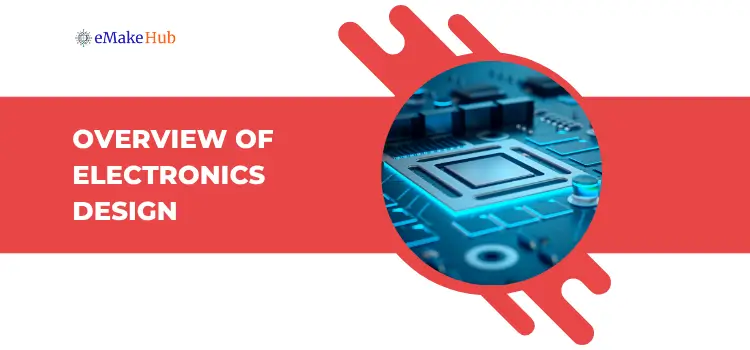Electronics design is the backbone of modern technology. From the smartphones in our pockets to the smart refrigerators in our kitchens, nearly every device we interact with is the result of thoughtful electronics design. But what exactly does this process involve, and why should non-engineers, like marketing professionals, care about it?
At its core, electronics design is about creating systems that solve problems or perform specific tasks using electronic components. Think of it as the process of bringing an idea to life in the form of a functional device. Whether it’s designing the circuit that powers a smartwatch or the printed circuit board (PCB) that runs a home automation system, electronics design ensures that today’s technology works seamlessly.
Let’s break down the essentials of electronics design in a clear way:
What is Electronics Design?
At its simplest, electronics design is the process of creating systems and devices that use electrical components to perform specific tasks or solve real-world problems. It’s the foundational step behind every piece of technology we use today, from the smallest household gadget to the most advanced industrial machinery.
To make this idea more accessible, imagine designing an electronic device as being similar to building a city:
- The circuits are like the roads that connect different parts of the city, allowing for the smooth flow of traffic (electricity).
- The components (like resistors, transistors, and chips) are the buildings and infrastructure that give the city its unique purpose and functionality.
- The PCB (Printed Circuit Board) acts as the blueprint or layout plan that organizes everything in the right place for efficient operation.
Electronics design doesn’t exist in isolation—it’s the bridge between hardware (the physical components) and software (the programs that tell the device what to do).
Key Components of Electronics Design
Understanding the key components of electronics design is essential for grasping how electronic devices function. Each component plays a specific role in the overall system, and together they create the intricate networks that power our technology. Let’s explore these components in detail.
Circuits: The Pathways of Electricity
At the heart of every electronic device lies the circuit, which serves as the pathway for electricity to flow. Circuits can be simple or complex, depending on the device’s functionality.
Components: The Building Blocks of Electronics
Components are the individual parts that make up a circuit. They can be categorized into two main types: active and passive components.
Printed Circuit Boards (PCBs): The Backbone of Electronics
Once the circuit and components are defined, the next step is to create a printed circuit board (PCB). The PCB serves as the physical foundation that holds and connects all the electronic components.
The Electronics Design Process
The electronics design process is a structured approach that guides designers from the initial concept to the final product. It involves multiple steps, each crucial for ensuring that the electronic device meets its intended specifications and functions reliably. Let’s break down this process into five key stages:
Understanding Requirements: The first step in the electronics design process involves gathering and defining the requirements for the device. This stage is critical because it sets the direction for the entire project. Key activities include: Identifying the Problem, Defining Functionality, Establishing Constraints
schematic design: Once the requirements are established, the next step is to create a schematic diagram. This is essentially a visual representation of the circuit, showing how components are connected and the flow of electricity within the system.
Prototyping: Prototyping is where the theoretical design is brought to life. This stage involves building a physical version of the device to test its functionality and performance. Prototyping is a critical phase because it provides the first tangible evidence of how the design performs in the real world.
PCB layout design: After validating the prototype, the next step is to design the PCB layout. This involves arranging the components on the board and creating the pathways that connect them.
testing & debugging: The final stage of the electronics design process involves thorough testing and debugging of the assembled PCB. Testing and debugging are essential to ensure that the final product is safe, effective, and ready for market.
The electronics design process is an iterative and collaborative effort that requires careful planning, creativity, and technical knowledge.
Tools and Software in Electronics Design
Electronics design relies heavily on specialized tools and software to bring ideas to life. From creating circuit diagrams to simulating performance and manufacturing PCBs, these tools play a critical role in simplifying complex tasks and ensuring the final product meets quality standards. Let’s explore some of the key categories of tools and the most popular software used by electronics designers.
CAD Software for Schematic Design and PCB Layout: Computer-Aided Design (CAD) software is a cornerstone of electronics design. It allows engineers to create detailed schematics and PCB layouts, ensuring accuracy and efficiency throughout the design process. Some popular software are Altium Designer, Eagle (by Autodesk), KiCad..
Simulation Tools for Circuit Testing: Before building a physical prototype, simulation tools allow engineers to test how their circuits will perform under various conditions. This helps identify and fix issues early in the design process. SPICE (Simulation Program with Integrated Circuit Emphasis), LTspice (by Analog Devices), and Proteus are some of the popular tools.
Prototyping Platforms: Prototyping platforms provide a hands-on way to test designs quickly and inexpensively. These platforms are especially helpful during the early stages of development. Platforms that can help you are Arduino, Raspberry Pi, Breadboards.
3D Design Tools for Enclosure Design: An electronic device isn’t just about the circuit—it also needs a physical enclosure. 3D design tools help create housings that protect and enhance the usability of the electronics. Fusion 360 (by Autodesk) or SolidWorks can help you design the enclosure.
Manufacturing and Production Tools: Once the design is complete, tools are needed to prepare files for manufacturing and ensure the product can be mass-produced efficiently. Some popular tools are CAM350 and EasyEDA.
The Impact of Electronics Design Business Growth
Electronics design is not just a technical process—it has far-reaching implications for business Growth. With the rapid advancement of technology, companies that understand the role of electronics design can create innovative products, improve customer experiences, and establish a competitive edge in their industries. Let’s explore how electronics design influences key aspects of business growth.
Driving Innovation and Differentiation: Electronics design is at the heart of innovation. It enables companies to create cutting-edge products that solve real-world problems and offer unique features to customers. For businesses, this is a powerful way to stand out in competitive markets.
Enhancing Customer Experiences: Electronics design plays a crucial role in shaping how customers interact with and perceive a product. A seamless, user-friendly experience often stems from well-thought-out electronics design.
Reducing Costs and Time to Market: Efficient electronics design processes can significantly reduce development costs and shorten the time it takes to bring a product to market. This has a direct impact on business profitability and competitiveness.
Enabling Personalization and Customization: Modern electronics design supports personalization, allowing businesses to create products tailored to individual customers or specific market segments.
Addressing Sustainability and Environmental Concerns: Electronics design also impacts how businesses address environmental and sustainability challenges, which are increasingly important to customers.
Challenges in Electronics Design
Designing modern electronic devices is a complex process that involves navigating a variety of technical, logistical, and market-related challenges. Electronics designers face numerous obstacles that require careful planning and problem-solving. Let’s explore some of the most common challenges in electronics design.
Miniaturization and Space Constraints: Modern electronics are becoming increasingly compact, with devices like smartphones, wearables, and medical implants requiring complex functionality in tiny form factors. However, designing for miniaturization comes with its own set of challenges.
Managing Signal Integrity and Noise: As circuits become more complex and operate at higher frequencies, managing signal integrity and reducing noise becomes a critical challenge.
Power Management and Energy Efficiency: As devices become smaller and more portable, managing power consumption becomes increasingly challenging. Designers must ensure that devices operate efficiently while maximizing battery life.
Keeping Up with Rapidly Evolving Technology: The electronics industry evolves at a rapid pace, with new technologies, components, and standards emerging constantly. Designers must stay up to date to remain competitive.
Emerging Trends in Electronics Design
As technology evolves, so does the field of electronics design. New trends are constantly reshaping how designers approach their work, leading to innovative products and improved processes. Here are some trends:
Internet of Things (IoT) Integration: The Internet of Things (IoT) is revolutionizing the way devices communicate and interact with each other. Electronics design is at the forefront of this trend, enabling the creation of smart, connected devices that enhance user experiences.
Miniaturization and Wearable Technology: The trend of miniaturization continues to dominate electronics design, making devices smaller and more powerful. This has led to the rise of wearable technology that seamlessly integrates into users’ lives.
Increased Automation in Design Processes: Automation is set to play a significant role in streamlining the electronics design process. With the rise of AI and machine learning, designers may increasingly rely on automated tools to enhance efficiency and accuracy.
Conclusion
The field of electronics design is a dynamic and multifaceted discipline that plays a crucial role in shaping the technology we use every day. From the initial concept through to prototyping, testing, and production, the design process is filled with both challenges and opportunities. As we have explored throughout this article, understanding the intricacies of electronics design not only benefits designers and engineers but also has significant implications for businesses as a whole.
















Comments
Global Resorts Network Grn Putting Timeshares
Android nougat begins rolling out to nexus
How to cheat at gossip movies and get away
Star Trek gets closer to becoming home tech
Android nougat begins rolling out to nexus